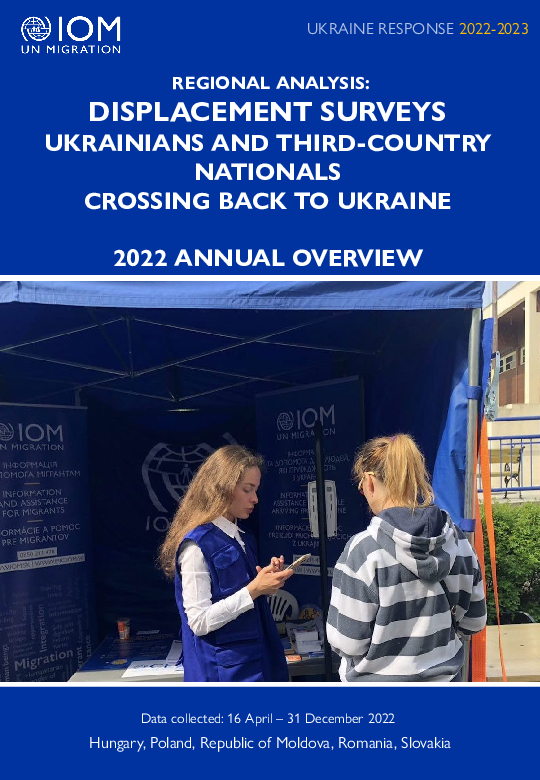-
Countries
-
Data and Analysis
-
Special Focus
-
Crisis Responses
Return migration
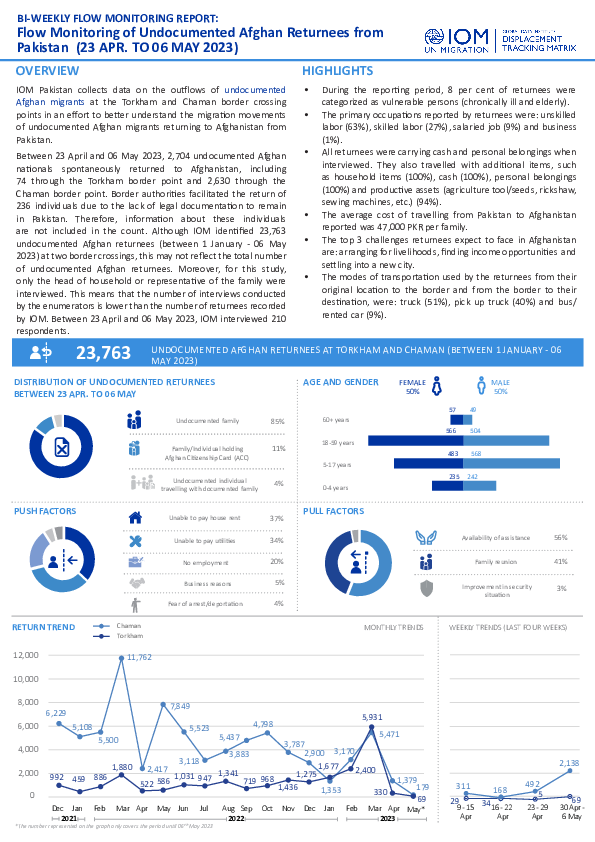
Contact
DTM Pakistan, iomisbdtmremapteam@iom.int
Language
English
Location
Pakistan
Period Covered
Apr 23 2023
May 06 2023
Activity
- Flow Monitoring
IOM Pakistan collects data on the outflows of undocumented Afghan migrants at the Torkham and Chaman border crossing points in an effort to better understand the migration movements of undocumented Afghan migrants returning to Afghanistan from Pakistan.
Between 23 April and 06 May 2023, 2,704 undocumented Afghan nationals spontaneously returned to Afghanistan, including 74 through the Torkham border point and 2,630 through the Chaman border point. Border authorities facilitated the return of 236 individuals due to the lack of legal documentation to remain in Pakistan. Therefore, information about these individuals are not included in the count. Although IOM identified 23,763 undocumented Afghan returnees (between 1 January - 06 May 2023) at two border crossings, this may not reflect the total number of undocumented Afghan returnees. Moreover, for this study, only the head of household or representative of the family were interviewed. This means that the number of interviews conducted by the enumerators is lower than the number of returnees recorded by IOM. Between 23 April and 06 May 2023, IOM interviewed 210 respondents.
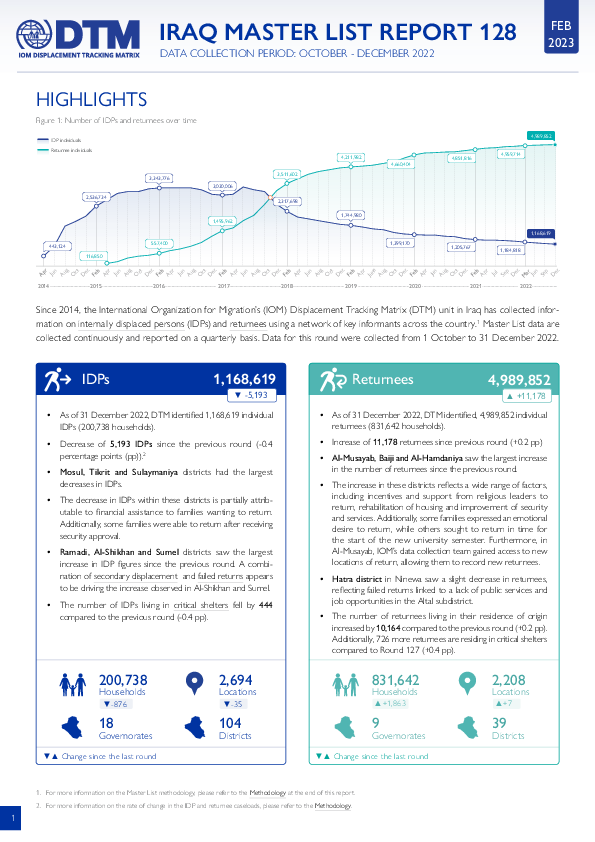
Contact
DTM Iraq, IraqDTM@iom.int
Language
English
Location
Iraq
Period Covered
Oct 01 2022
Dec 31 2022
Activity
- Mobility Tracking
- Baseline Assessment
Since 2014, the International Organization for Migration’s (IOM) Displacement Tracking Matrix (DTM) unit in Iraq has collected information on internally displaced persons (IDPs) and returnees using a network of key informants across the country.1 Master List data are collected continuously and reported on a quarterly basis. Data for this round were collected from 1 October to 31 December 2022.
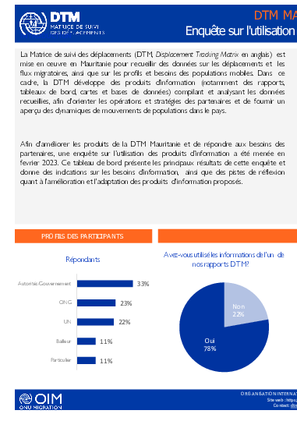
Contact
dtmmauritania@iom.int
Language
French
Location
Mauritania
Period Covered
Feb 07 2023
Feb 18 2023
Activity
- Other
La Matrice de suivi des déplacements ( Displacement Tracking Matrix en anglais) est mise en oeuvre en Mauritanie pour recueillir des données sur les déplacements et les flux migratoires, ainsi que sur les profils et besoins des populations mobiles.
Dans ce cadre, la DTM développe des produits d'information (notamment des rapports, tableaux de bord, cartes et bases de données) compilant et analysant les données recueillies, afin d'orienter les opérations et stratégies des partenaires et de fournir un aperçu des dynamiques de mouvements de populations dans le pays. Afin d'améliorer les produits de la DTM Mauritanie et de répondre aux besoins des partenaires, une enquête sur l’utilisation des produits d’information a été menée en février 2023.
Ce tableau de bord présente les principaux résultats de cette enquête et donne des indications sur les besoins d’information, ainsi que des pistes de réflexion quant à l'amélioration et l'adaptation des produits d'information proposés.
Starting on 24 February 2022, the Russian full-scale invasion of Ukraine triggered an unprecedented humanitarian crisis and generated large scale displacement both within Ukraine and to the neighbouring countries. As of 23 January 2023,1 5.4 million persons were internally displaced in Ukraine. Moreover, in Mid-January 2023 nearly eight million refugees from Ukraine were recorded across Europe.2 According to available administrative data, more than 17 million border crossings of Ukrainian and Third-Country refugees and migrants were reported from Ukraine into the neighbouring countries since February 2022. At the same time, around 5.2 million persons were estimated to be returnees including both from other locations within Ukraine and self-reported from abroad as of 5 December 2022.3 Nearly nine million cross-border movements were registered from Poland, Romania, Slovakia, and the Republic of Moldova among the neighbouring countries into Ukraine as of the end of January 2023.4
IOM has deployed its Displacement Tracking Matrix (DTM) tools since mid-April 2022 to collect individual surveys in neighbouring countries with persons crossing into Ukraine, with the aim to improve the understanding of main profiles, displacement patterns, intentions and needs of those moving into Ukraine.
This report is based on 24,393 valid surveys collected by IOM’s DTM in five countries, with Ukrainian and Third-Country refugees and migrants crossing to Ukraine, between 16 April and 31 December 2022: 8,743 in Romania, 7,131 in the Republic of Moldova 6,807 in Poland, 1,037 in Hungary, and 675 in Slovakia. Total results are weighted as per the number of border crossings into Ukraine from each country of the survey, during the afore-mentioned period. Results are also presented by period of the data collection to show the evolution of profiles, needs and intentions from Quarter 2 of 2022 (from April to June), to Quarter 3 (July-September) and Quarter 4 (October-December).
Movements back to Ukraine can be pendular, and do not necessarily indicate sustainable intentions to stay as the situation across the country remains highly volatile and unpredictable. Hence, individuals surveyed while crossing into Ukraine from neighbouring countries are not necessarily returnees, and conclusions on definitive trends cannot be drawn.
For a complementary discussion on returnees within Ukraine, after internal or international displacement, please check the latest DTM Ukraine Return Report (January 2023) and the Factsheet Conditions of Return Assessment (February 2023).
Starting on 24 February 2022, the Russian full-scale invasion in Ukraine triggered an unprecedented humanitarian crisis and generated large scale displacement, both within Ukraine and to the neighbouring countries. As of 23 January 2023, 5.4 M persons were internally displaced in Ukraine (IOM). Moreover, by mid-January 2023 nearly 8 M refugees from Ukraine were recorded across Europe (UNHCR). According to available administrative data, more than 17 M border crossings of refugees and Third-Country Nationals (TCNs) were reported from Ukraine into the neighbouring countries since February 2022.1
At the same time, around 5.2 M persons were estimated to be returnees including both from other locations within Ukraine and self-reported from abroad as of 5 December 2022 (IOM). Nearly 9 M cross-border movements were registered from Poland, Romania, Slovakia, and the Republic of Moldova among the neighbouring countries into Ukraine as of the end of January 2023.
To survey the reasons for crossing back to Ukraine, and the intentions and immediate needs of the populations returning or only visiting for short periods, IOM deployed its Displacement Tracking Matrix (DTM) since April 2022 and interviewed Ukrainians and TCNs in neighbouring countries prior to exiting towards Ukraine.
This report is based on 24,393 valid surveys collected by IOM’s DTM in five countries with adult refugees from Ukraine and TCNs, that were crossing back into the country between 16 April and 31 December 2022: 8,743 in Romania, 7,131 in the Republic of Moldova, 6,807 in Poland, 1,037 in Hungary, 675 in Slovakia.
Total results are weighted as per the number of border crossings from each country of the survey, during the afore-mentioned period. Movements back to Ukraine can be pendular, and do not necessarily indicate intentions to stay as the situation across the country remains volatile and unpredictable.
For a complementary discussion on returnees within Ukraine, after internal or international displacement, please check the latest DTM Ukraine Return Report (January 2023) and the Factsheet Conditions of Return Assessment (February 2023).
Read the Extended version of the Report here.
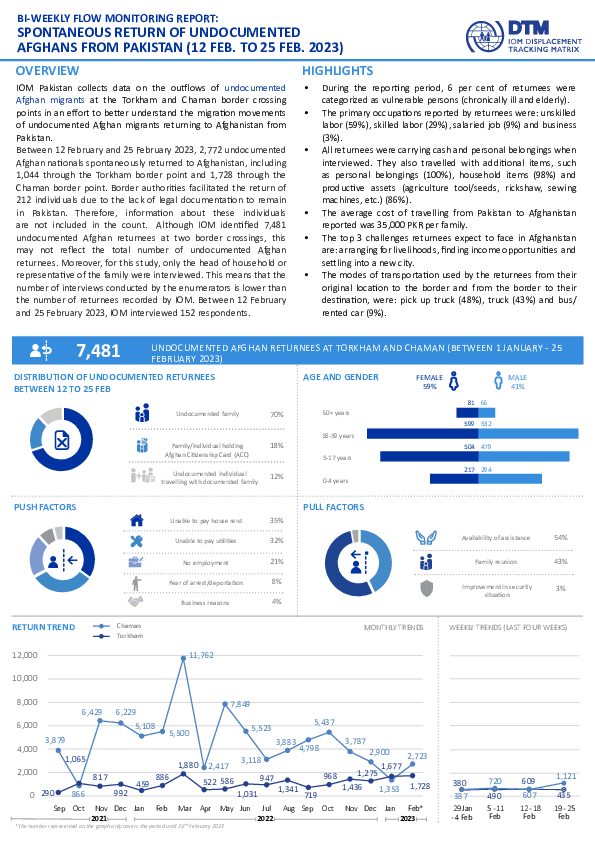
Contact
DTM Pakistan, iomisbdtmremapteam@iom.int
Language
English
Location
Pakistan
Period Covered
Feb 12 2023
Feb 25 2023
Activity
- Flow Monitoring
IOM Pakistan collects data on the outflows of undocumented Afghan migrants at the Torkham and Chaman border crossing points in an effort to better understand the migration movements
of undocumented Afghan migrants returning to Afghanistan from Pakistan. This exercise is part of the European Union funded project “Displacement Tracking Matrix Regional Evidence for Migration
Analysis and Policy (DTM REMAP)”.
Between 12 February and 25 February 2023, 2,772 undocumented Afghan nationals spontaneously returned to Afghanistan, including 1,044 through the Torkham border point and 1,728 through the Chaman border point. Border authorities facilitated the return of 212 individuals due to the lack of legal documentation to remain in Pakistan. Therefore, information about these individuals are not included in the count. Although IOM identified 7,481 undocumented Afghan returnees at two border crossings, this may not reflect the total number of undocumented Afghan returnees. Moreover, for this study, only the head of household or representative of the family were interviewed. This means that the number of interviews conducted by the enumerators is lower than the number of returnees recorded by IOM. Between 12 February and 25 February 2023, IOM interviewed 152 respondents.

Contact
DTM Pakistan, iomisbdtmremapteam@iom.int
Language
English
Location
Pakistan
Period Covered
Jun 18 2022
Jul 01 2022
Activity
- Flow Monitoring
IOM Pakistan collects data on the outflows of undocumented Afghan migrants at the Torkham and Chaman border crossing points in an effort to better understand the migration movements of undocumented Afghan migrants returning to Afghanistan from Pakistan. This exercise is part of the European Union funded project “Displacement Tracking Matrix Regional Evidence for Migration Analysis and Policy (DTM REMAP)”.
From 18 June to 01 July 2022, 2,906 undocumented Afghan migrants returned to Afghanistan from Pakistan, including 705 through the Torkham border point and 2,201 through the Chaman border point. During the reporting period, border authorities facilitated the return of 74 individuals due to the lack of legal documentation to remain in Pakistan. Therefore, information concerning these 74 individuals is not included in the report analysis.

Contact
DTMUkraine@iom.int
Language
English
Location
Ukraine
Period Covered
Jan 16 2023
Jan 23 2023
Activity
- Survey
Щоб підтримати партнерів у наданні цільової, заснованої на фактах допомоги найбільш уразливим верствам населення серед тих, хто повернувся до місць свого постійного проживання після періоду вимушеного переміщення, Матриця Відстеження Переміщень в Україні (DTM Ukraine) представляє третій звіт про повернення в Україні. Це видання за січень 2023 року включає детальний аналіз даних, зібраних під час дванадцятого раунду Загального опитування населення МОМ, проведеного з 16 по 23 січня 2023 року серед дорослого населення України.
Це видання Звіту про повернення в Україну містить дані та аналіз профілю та намірів переміщених осіб за кордоном, надані Регіональним офісом МОМ у Відні. Звіт також містить попередні результати першого раунду оцінки умов повернення МОМ (CoRA), багатогалузевої оцінки локацій, проведеної у ключових областях повернення в січні та лютому 2023 року. На додаток до основних модулів опитування, 12 раунд надає детальну інформацію про дохід домогосподарств осіб, які повернулися, передбачуване використання грошової допомоги та середньомісячні витрати на оплату комунальних послуг та інші витрати на опалення.
Для цілей цього звіту терміни «повернення» і «особа, яка повернулася» вжито без обмежень щодо статусу на позначення будь яких осіб, які наразі перебувають у своїх звичних місцях проживання після тривалого періоду переміщення (щонайменше два тижні, починаючи з лютого 2022 року незалежно від того, чи вони спонтанно повернулися до цих місць з за кордону, чи з місць внутрішнього переміщення в межах України. Це визначення не охоплює осіб, які повернулися в Україну з за кордону, але не повернулися до своїх звичних місць проживання в країні.
Цей звіт про повернення англійською мовою можна переглянути тут.

Contact
DTMUkraine@iom.int
Language
English
Location
Ukraine
Period Covered
Jan 16 2023
Jan 23 2023
Activity
- Survey
To support partners in providing targeted, evidence-based assistance to the most vulnerable among those who have returned to their areas of habitual residence following a period of forced displacement, DTM Ukraine presents the third Ukraine Returns report. This January 2023 edition includes a detailed analysis of data collected through the twelfth round of IOM’s General Population Survey, conducted between 16 and 23 January 2023 among the adult population in Ukraine
This edition of the Ukraine Returns Report includes data and an analysis of the profile and intentions of those displaced abroad provided by the IOM Regional Office in Vienna. It also provides preliminary findings from the first round of IOM’s Conditions of Return Assessment (CoRA), a multi-sectoral location assessment deployed across key oblasts of return conducted in January and February 2023. In addition to the core survey modules, Round 12 offers detailed data on the household income of the returnee population, the envisaged usage of financial assistance and average monthly expenditure on utilities and other heating costs.
For the purposes of this report, the terms "return” and "returnee” are used without prejudice to status and refer to all persons de-facto in their place of habitual residence after a significant period of displacement (minimum of two weeks since February 2022), regardless of whether they returned to these locations spontaneously from abroad or from displacement within Ukraine. This definition excludes those who have come back to Ukraine from abroad but who have not returned to their places of habitual residence in country.
This Returns report in Ukrainian may be accessed here.
Migration picked up significantly across the three migratory corridors in the East and Horn of Africa region in 2022, thus marking the end of the impact of COVID-19-related restrictions on mobility flows. Migration along the Eastern Route, which runs from the Horn of Africa to the Arabian Peninsula, mostly to the Kingdom of Saudi Arabia, increased by 64 per cent between 2021 and 2022 (from 269,000 to 441,000 migrant movements). The number of children travelling alone doubled in the last year (from 7,300 to 14,900) and these unaccompanied children represented 38 per cent of all children tracked in 2022 (39,700). Similarly, the number of female migrants travelling along the Eastern Route also doubled (from 53,200 to 106,700).
Pagination
- Previous page
- Page 7
- Next page
